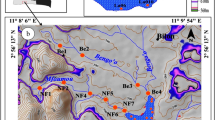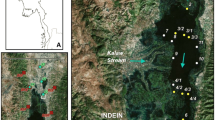Abstract.
Unconsolidated sediment at the bottom of the Berkeley pit lake is a mixture of detrital silicate minerals derived from sloughing of the pit walls and secondary minerals precipitated out of the water column. The latter include gypsum and K-rich jarosite. The pore waters have a similar pH to the overlying lake waters (pH 3.1 to 3.4), and have similarly high concentrations of dissolved heavy metals, including Al, Cd, Cu, Mn, Ni, and Zn. Sediment cores show that the top meter of the sediment column is moderately oxidized (jarosite-stable). Petrography, chemical analysis and geochemical modelling all suggest a transformation of poorly crystalline ferric compounds such as schwertmannite and/or ferrihydrite near the sediment surface to jarosite with depth in the core. No evidence of bacterial sulfate reduction was found in this study, despite the presence of 0.3 to 0.4 wt% organic carbon in the pit lake sediment.
Similar content being viewed by others
Author information
Authors and Affiliations
Corresponding author
Rights and permissions
About this article
Cite this article
Twidwell, L.G., Gammons, C.H., Young, C.A. et al. Summary of Deepwater Sediment/Pore Water Characterization for the Metal-laden Berkeley Pit Lake in Butte, Montana. Mine Water Environ 25, 86–92 (2006). https://doi.org/10.1007/s10230-006-0115-5
Received:
Accepted:
Issue Date:
DOI: https://doi.org/10.1007/s10230-006-0115-5




